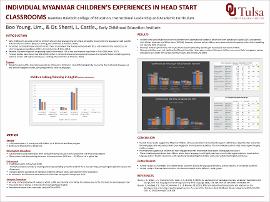| dc.description.abstract | BACKGROUND: Early childhood is a crucial period for children who are dual language learners (DLLs), struggling to learn the new language as well as other skills for school readiness. In contrast to comprehensive research in ECE, there are relatively few studies conducted with DLLs, and mainly for the Latino DLLs, no other language groups. Recently, Myanmar migrants are growing rapidly and make up 25% of the total migrant population in Tulsa (NBC news, 2017). Previous studies have shown that DLL children differ in various developmental outcomes because of a myriad of factors including poverty, systemic racism, and oppression. The researchers examined the classroom experiences of Myanmar children in a Head Start program by measuring their individual language use and level of engagement then, comparing them to other racial groups.
METHODS: The participants included 3- and 4-year-old children (n=1,101) in a Head Start program in Northeast OK. The measure used the Child Observational Protocol, which involved 3-second sweeps which snapshots of individual children’s behavior across a period of time in the classroom. Observers spent approximately 4 hours in the classroom on a typical morning. All children in the classroom were observed and had an average of 9 sweeps per child. The current study specifically focused on the proportion of sweeps in which a child was listening to or talking to someone else in the classroom (in any language) and the proportion of sweeps a child was observed speaking in English. Descriptive analyses were conducted using ANOVA in SPSS.
RESULTS: Results indicated that children who speak Myanmar at home had fewer times observational sweeps in which they were speaking in English (15%) compared to their African American and White peers (19-20%). However, whereas Latino children were observed more frequently to be neither speaking nor listening (45% of sweeps), Myanmar children were not significantly different than their Latino peers. Instead, Myanmar children were more likely to engage in passive instruction (15%) than their African American (10%) and White (12%) peers.
CONCLUSION: Our findings suggest that Myanmar children who were enrolled in a Head Start program had bit fewer opportunities to practice their language skills and are less likely to be engaged in their classroom activities. Further research is needed to see whether these outcomes are due to language proficiency, cultural aspects, or influenced by others. This information also leads to the need for further study of how teachers interact in the classroom based on the racial groups. | en_US |

